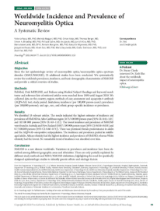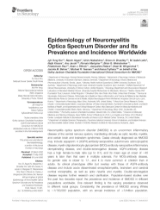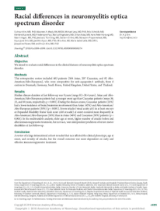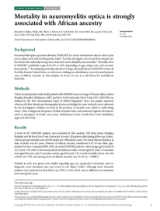Rimler Z, et al. Mortality in neuromyelitis optica is strongly associated with African ancestry. Neurol Neuroimmunol Neuroinflamm. 2018;5(4): e468. 2. Hor JY, Asgari N, Nakashima I, et al. Epidemiology
of neuromyelitis optica spectrum disorder
and its prevalence and incidence worldwide. Front Neurol. 2020;11:501. 3. Hoffman
KM, Trawalter S, Axt JR, Oliver MN. Racial bias in pain assessment and treatment recommendations, and false beliefs about biological differences between blacks and whites. Proc Natl Acad Sci USA.
2016;113(16):4296-4301. 4. Bukhari W, Prain KM, Waters P, et al. Incidence and prevalence of NMOSD in Australia and New Zealand. J Neurol Neurosurg Psychiatry. 2017;88(8):632-638. 5. Papp V, Magyari
M, Aktas O, et al. Worldwide incidence and prevalence of neuromyelitis optica: a systematic review. Neurology. 2021;96(2):59-77. 6. Kim S-H. Mealy MA, Levy M, et al. Racial differences in neuromyelitis optica spectrum disorder. Neurology. 2018;91(22):e2089-e2099. 7. Wingerchuk DM, Banwell B, Bennett JL, et
al. International consensus diagnostic
criteria for neuromyelitis optica spectrum disorders. Neurology. 2015;85(2):177-189. 8. Trebst C, Jarius S, Berthele A, et al. Update on the diagnosis and treatment of neuromyelitis optica: recommendations of
the Neuromyelitis Optica Study Group (NEMOS). J Neurol. 2014;261(1):1-16. 9. Boring BL, Ng BW, Nanavaty N, Mathur VA. Over-rating pain is overrated: a fundamental self-other bias in pain reporting behavior. J Pain. 2022;23(10):1779-1789. 10. Jarius S, Ruprecht K, Wildemann B, et al. Contrasting disease patterns in seropositive and seronegative neuromyelitis optica: a multicentre study of 175 patients. J Neuroinflammation. 2012;9:14. 11. Kitley
J, Leite MI, Nakashima I, et al. Prognostic factors and disease course in aquaporin-4 antibody-
positive patients with
neuromyelitis optica spectrum disorder from the United Kingdom and Japan. Brain. 2012;135(pt 6):1834-1849.














